'Out of Sight, Out of Mind' — 4 Ways to Hide the Light Wires Under a Kitchen Cabinet
While undercabinet lights are super practical, they have a small downside — their visible network of wires can spoil the look of the room. Experts tell us how to hide this eyesore


Undercabinet lighting in the kitchen doesn't have to come with the appendage of exposed wires. With some forethought, planning, preparation, and clever designs, these stray bits sticking out of line can be concealed or placed away from direct sightlines.
To help you with ideas, we reached out to experts for suggestions. Take a look at these modern kitchen ideas that help make undercabinet lights the hero of the scheme without exposing their downside.
1. Add a wire cover

Undercabinet lights are quite essential to the kitchen lighting design. These are those task lights that provide crucial and focused illumination for food prep and also help bring focus to the countertop and its wonderful details. A good way to make the most of this element without dealing with hanging wires is with a wire cover.
'If you're choosing LED strip lights, chances are that the wires will be small but still visible,' says Jane Lockhart, founder of Jane Lockhart Design. 'Some brands sell a cover for wires which can be installed on the wall and painted to match the space.'
2. Build a light box inside the cabinet

A light box, that holds all the wires can be built into the upper cabinets. While some semi-custom kitchen cabinet firms offer a standard height, which is typically about 1 ¼” box height, you can have a custom one created just for you. A local contractor could help you make this cabinet modification, creating a 7/8” box for that streamlined look.
'You could also have a low profile cabinet light tucked behind the front lip of the cabinet; a detail that needs to be coordinated with the cabinet shop so they can extend the bottom front trim of the cabinets when they are building them,' says Ariel Bleich, founder of Ariel Bleich Design. 'If you are adding this after they are built, consider adding a trim to the front of the cabinet to conceal all of this assuming the light being used is low profile enough.'
3. Route the wires behind the cabinet

If you have the advantage of building your cabinets from scratch, consider this wonderful option. For recessed kitchen cabinet lights, add a wooden plank on the top with a hole and a channel, so you can feed the wiring through the cabinet and into the outlet on the back wall.
'Push the electrical wires through the cabinet by drilling a hole in the bottom, and running the wire to the other side so it's not visible in the front,' says Jane. 'Always be safe when it comes to electricity, and engage more people if you can.'
4. Add a wooden valence
Extend the front face of the wooden kitchen cabinet by adding a wooden valance to the underside. You can ask a contractor to do so for you or even use a wood adhesive to install a long plank. Make sure the valance material matches exactly with the existing cabinets. Use L-brackets or pin nails to hold it in position. Note: This is the most budget-friendly way to hide under cabinet lighting.
'And if building or installing new contraptions is a complete no-no for you, go for wireless puck lights that need batteries and do not have the issues of wires at all,' says Jane.
3 products that can hide undercabinet wires

Material: Neoprene
Price: $44

Material: Durable wood
Price: $80

Dimensions: 125"L x 0.59"W
Price: $11
Be The First To Know
The Livingetc newsletter is your shortcut to the now and the next in home design. Subscribe today to receive a stunning free 200-page book of the best homes from around the world.
Aditi Sharma Maheshwari is an architecture and design journalist with over 10 years of experience. She's worked at some of the leading media houses in India such as Elle Decor, Houzz and Architectural Digest (Condé Nast). Till recently, she was a freelance writer for publications such as Architectural Digest US, House Beautiful, Stir World, Beautiful Homes India among others. In her spare time, she volunteers at animal shelters and other rescue organizations.
-
 5 Things People With Flattering Bathrooms Never Have — (And You Shouldn't Either!)
5 Things People With Flattering Bathrooms Never Have — (And You Shouldn't Either!)Designers say you should avoid these five things if you want a bathroom that flatters your reflection and therefore uplifts your mood
By Oonagh Turner Published
-
 How to Organize your Bathroom for a Better Morning Routine — 6 Steps for a Seamless Start to the Day
How to Organize your Bathroom for a Better Morning Routine — 6 Steps for a Seamless Start to the DayThe ease of your morning routine can have a huge influence over the rest of the day, so make sure you optimize you space for a stress-free start to the day
By Lilith Hudson Published

